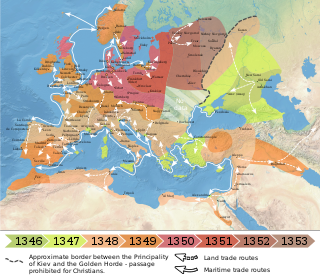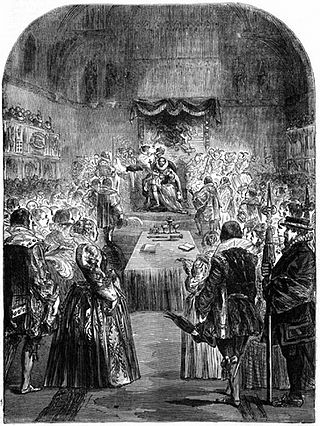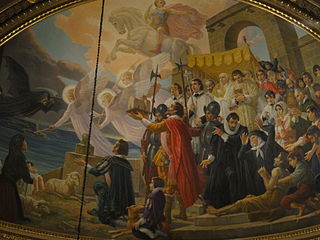
The Black Death was a bubonic plague pandemic that occurred in Europe from 1346 to 1353. It was one of the most fatal pandemics in human history; as many as 50 million people perished, perhaps 50% of Europe's 14th century population. The disease is caused by the bacterium Yersinia pestis and spread by fleas and through the air. One of the most significant events in European history, the Black Death had far-reaching population, economic, and cultural impacts. It was the beginning of the second plague pandemic. The plague created religious, social and economic upheavals, with profound effects on the course of European history.

The Great Plague of London, lasting from 1665 to 1666, was the most recent major epidemic of the bubonic plague to occur in England. It happened within the centuries-long Second Pandemic, a period of intermittent bubonic plague epidemics that originated in Central Asia in 1331, and included related diseases such as pneumonic plague and septicemic plague, which lasted until 1750.

The third plague pandemic was a major bubonic plague pandemic that began in Yunnan, China, in 1855. This episode of bubonic plague spread to all inhabited continents, and ultimately led to more than 12 million deaths in India and China, and at least 10 million Indians were killed in British Raj India alone, making it one of the deadliest pandemics in history. According to the World Health Organization, the pandemic was considered active until 1960, when worldwide casualties dropped to 200 per year. Plague deaths have continued at a lower level for every year since.

The Naples Plague was an epidemic of plague in the Kingdom of Naples, lasting from 1656 to 1658. The epidemic affected mostly Central Italy and Southern Italy, killing up to 1,250,000 people throughout the Kingdom of Naples according to some estimates.

The Italian plague of 1629–1631, also referred to as the Great Plague of Milan, was part of the second plague pandemic that began with the Black Death in 1348 and ended in the 18th century. One of two major outbreaks in Italy during the 17th century, it affected northern and central Italy and resulted in at least 280,000 deaths, with some estimating fatalities as high as one million, or about 35% of the population. The plague may have contributed to the decline of Italy's economy relative to those of other Western European countries.

"O du lieber Augustin" is a popular Viennese song, first published about 1800. It is said to refer to the balladeer Marx Augustin and his brush with death in 1679. Augustin himself is sometimes named as the author, but the origin is unclear.

The Great Plague of Marseille, also known as the Plague of Provence, was the last major outbreak of bubonic plague in Western Europe. Arriving in Marseille, France, in 1720, the disease killed over 100,000 people: 50,000 in the city during the next two years and another 50,000 to the north in surrounding provinces and towns.

The Plague Column, or Trinity Column, is a Holy Trinity column located on the Graben, a street in the inner city of Vienna, Austria. Erected after the Great Plague epidemic in 1679, the Baroque memorial is one of the best known and most prominent sculptural artworks in the city. Christine M. Boeckl, author of Images of Plague and Pestilence, calls it "one of the most ambitious and innovative sculptural ensembles created anywhere in Europe in the post-Bernini era."

The Great Plague of Seville (1647–1652) was a massive outbreak of disease in Spain that killed up to a quarter of Seville's population.
Globalization, the flow of information, goods, capital, and people across political and geographic boundaries, allows infectious diseases to rapidly spread around the world, while also allowing the alleviation of factors such as hunger and poverty, which are key determinants of global health. The spread of diseases across wide geographic scales has increased through history. Early diseases that spread from Asia to Europe were bubonic plague, influenza of various types, and similar infectious diseases.

Bubonic plague is one of three types of plague caused by the bacterium Yersinia pestis. One to seven days after exposure to the bacteria, flu-like symptoms develop. These symptoms include fever, headaches, and vomiting, as well as swollen and painful lymph nodes occurring in the area closest to where the bacteria entered the skin. Acral necrosis, the dark discoloration of skin, is another symptom. Occasionally, swollen lymph nodes, known as "buboes", may break open.

The fifth cholera pandemic (1881–1896) was the fifth major international outbreak of cholera in the 19th century. The endemic origin of the pandemic, as had its predecessors, was in the Ganges Delta in West Bengal. While the Vibrio cholerae bacteria had not been able to spread to western Europe until the 19th century, faster and improved modes of modern transportation, such as steamships and railways, reduced the duration of the journey considerably and facilitated the transmission of cholera and other infectious diseases. During the fourth 1863–1875 cholera pandemic, the third International Sanitary Conference convened in 1866 in Constantinople had identified religious pilgrimages to be "the most powerful of all causes" of cholera and again Hindu and Muslim pilgrimages were an important factor in the spread of the disease.

The Black Death was one of the most devastating pandemics in human history, resulting in the deaths of an estimated 75 to 200 million people in Eurasia, and peaking in Eurasia from 1321 to 1353. Its migration followed the sea and land trading routes of the medieval world. This migration has been studied for centuries as an example of how the spread of contagious diseases is impacted by human society and economics.
Theories of the Black Death are a variety of explanations that have been advanced to explain the nature and transmission of the Black Death (1347–51). A number of epidemiologists from the 1980s to the 2000s challenged the traditional view that the Black Death was caused by plague based on the type and spread of the disease. The confirmation in 2010 and 2011 that Yersinia pestis DNA was associated with a large number of plague sites has led researchers to conclude that "Finally, plague is plague."

The second plague pandemic was a major series of epidemics of plague that started with the Black Death, which reached medieval Europe in 1346 and killed up to half of the population of Eurasia in the next four years. It followed the first plague pandemic that began in the 6th century with the Plague of Justinian, but had ended in the 8th century. Although the plague died out in most places after 1353, it became endemic and recurred regularly. A series of major epidemics occurred in the late 17th century, and the disease recurred in some places until the late 18th century or the early 19th century. After this, a new strain of the bacterium gave rise to the third plague pandemic, which started in Asia around the mid-19th century.
Globally about 600 cases of plague are reported a year. In 2017 and November 2019 the countries with the most cases include the Democratic Republic of the Congo, Madagascar, and Peru.

The 1603 London plague epidemic was the first of the 17th century and marked the transition from the Tudor to the Stuart period.

The 1813–1814 Malta plague epidemic was the last major outbreak of plague on the islands of Malta and Gozo. It occurred between March 1813 and January 1814 on Malta and between February and May 1814 on Gozo, and the epidemic was officially declared to be over in September 1814. It resulted in approximately 4500 deaths, which was about 5% of the islands' population.

The 1675–1676 Malta plague epidemic was a major outbreak of plague on the island of Malta, then ruled by the Order of St John. It occurred between December 1675 and August 1676, and resulted in approximately 11,300 deaths, making it the deadliest epidemic in Maltese history. Most deaths were in the urban areas, including the capital Valletta and the Three Cities, which had a mortality rate of about 41%. In the rural settlements, the mortality rate was 6.9%.

The 1592–1593 Malta plague epidemic was a major outbreak of plague on the island of Malta, then ruled by the Order of St John. It occurred in three waves between June 1592 and September 1593, during the second plague pandemic, and it resulted in approximately 3000 deaths, which amounted to about 11% of the population. The disease was imported to Malta by Tuscan galleys that had captured vessels from Alexandria. In 1593, the Order requested assistance from Sicily to deal with the epidemic, and the measures taken were effective in containing plague.

















